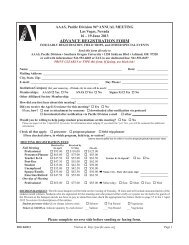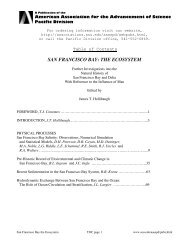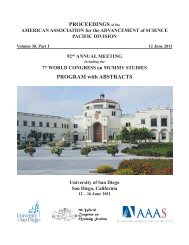Vol 31, Part I - forums.sou.edu ⢠Index page - Southern Oregon ...
Vol 31, Part I - forums.sou.edu ⢠Index page - Southern Oregon ...
Vol 31, Part I - forums.sou.edu ⢠Index page - Southern Oregon ...
Create successful ePaper yourself
Turn your PDF publications into a flip-book with our unique Google optimized e-Paper software.
ABSTRACTS – Symposia<br />
leading to aggregation and insolubilization. Deamidation, a<br />
prevalent age-related modification in the lens of the eye may<br />
also take place as a result of long term spaceflight, leading<br />
to a decrease in stability of the major lens proteins, crystallins.<br />
Deamidation is loss of a tertiary amino group on an<br />
Asn or Gln resulting in a carboxyl group with a net negative<br />
charge. Nonenzymatic deamidation may be facilitated<br />
by UV exposure. The mechanism of deamidation altering<br />
interactions between the αA-crystallin chaperone and βB2-<br />
crystallin was investigated by thermally inducing complex<br />
formation. Changes in solvent accessibility were detected<br />
by analysis with hydrogen/deuterium exchange coupled<br />
to high-resolution mass spectrometry. The mechanism of<br />
deamidation-dependent mechanisms of cataract formation<br />
through destabilization of crystallins before they can be rescued<br />
by α-chaperone will be discussed.<br />
15 Effects of Simulated Microgravity on Articular Chondrocytes,<br />
Liliana Mellor 1 *, lindsey catlin 1 ,<br />
raquel brown 1 , Warren Knudson 2 , and Julia<br />
Thom Oxford 1 ( 1 Boise State University, Biomolecular<br />
Research Center, Boise, ID 83725; 2 East Carolina University,<br />
Brody School of Medicine, Greenville, NC 27834; lilianamellor@boisestate.<strong>edu</strong>).<br />
Astronauts experience bone density loss after space flight<br />
resembling osteoporotic conditions due to prolonged exposure<br />
to microgravity. Although bone density loss in space is<br />
a growing field of interest, little is known about the effects<br />
of microgravity on the adjacent articular cartilage. Articular<br />
cartilage of the synovial joints such as hip and knee, are<br />
constantly exposed to mechanical forces produced by daily<br />
activities here on Earth. Similar to bone, cartilage is a type<br />
of connective tissue that requires a balance between synthesis<br />
and degradation of extracellular matrix components to<br />
maintain tissue homeostasis; changes in this balance leads to<br />
cartilage degradation. However, unlike bone tissue, cartilage<br />
lacks innervation, blood supply and cell-cell contact, and has<br />
a very limited regeneration capacity. Proper communication<br />
between individual chondrocytes and the extracellular matrix<br />
is crucial to maintain cartilage homeostasis, and disruption<br />
in cell-matrix interactions can trigger cartilage degradation.<br />
We use two chondrocyte cell lines widely used in arthritis<br />
cell research, RCS (rat chondrosarcoma cells) and C-28/I2<br />
(immortal human chondrocytes), and expose them to a modeled<br />
simulated microgravity environment using a rotating wall<br />
vessel (RWV) bioreactor. We optimized culture conditions for<br />
each cell line in a 3-D environment by testing different microcarriers<br />
and assessing cell viability after several days in the<br />
bioreactor. A better understanding of the molecular signaling<br />
pathways involved in cartilage degradation, will not only help<br />
prevent astronauts developing osteoarthritis from exposure to<br />
microgravity, but will also help us prevent further degradation<br />
in patients experiencing early stages of arthritis on Earth.<br />
16 A Role for PTHrP in Expression of Minor Fibrillar Collagens,<br />
NEDA SHEFA*, MINOTI HIREMATH, and<br />
JULIA THOM OXFORD (Biological Sciences Department,<br />
Boise State University, 1910 University Dr. Boise, ID<br />
83725; nedashefa@boisestate.<strong>edu</strong>).<br />
Astronauts lose an average of 1-2% in bone mineral<br />
density for every month spent in microgravity. Bone remodeling<br />
is a tightly regulated system that involves formation<br />
of new bone by osteoblasts and resorption of old bone by<br />
osteoclasts. Microgravity uncouples bone remodeling and<br />
causes increased bone resorption. Many attempts have been<br />
made to understand the underlying causes of bone loss in<br />
microgravity but with limited success. Parathyroid hormonerelated<br />
protein (PTHrP) produced by bone cells stimulates<br />
bone formation. Spaceflight causes an 80-90% decrease in<br />
PTHrP mRNA levels. The uncoupling of bone remodeling<br />
in spaceflight could be a downstream effect of decreased<br />
PTHrP. Here, we test the hypothesis of PTHrP acting via collagen<br />
proteins in the extracellular matrix to regulate bone<br />
remodeling. Pre-osteoblasts were treated with PTHrP to<br />
assess the expression of minor fibrillar collagens by reverse<br />
transcriptase PCR. Recent studies show that Col5a3 is specifically<br />
expressed in newly synthesized bone, suggesting<br />
that PTHrP-mediated regulation of Col5a3 may contribute<br />
to new bone formation. Additionally, we treated C2C12<br />
pre-osteoblast cells with BMP-2 to differentiate them into<br />
osteoblasts and then treated them with PTHrP. We observed<br />
that PTHrP also changes the expression of different Col11a1<br />
isoforms in osteoblasts. In summary, our results demonstrate<br />
a crosstalk between PTHrP and the minor fibrillar collagens<br />
that may mediate bone formation during development and<br />
bone remodeling during exposure to microgravity.<br />
17 Interactions of Osteoblasts, Inflammation, and the Extracellular<br />
Matrix in Simulated Free Fall, Jake Goyden*,<br />
Benjamin DAVIS, Julia THOM Oxford, and<br />
Cheryl Jorcyk (Department of Biological Sciences,<br />
Biomolecular Research Center, Musculoskeletal Research,<br />
Boise State University, 1910 University Dr., Boise, ID<br />
83725; jakegoyden@u.boisestate.<strong>edu</strong>).<br />
Healthy bone repairs damage and adapts to changing<br />
mechanical demands by regulating the balance between bone<br />
destruction by osteoclasts and bone construction by osteoblasts.<br />
In space travel and significant terrestrial diseases like<br />
osteoporosis, bone is lost because osteoblasts activity falls<br />
behind relatively normal osteoclast activity. Osteoblast differentiation<br />
and activity interact with many systems, including<br />
the inflammatory microenvironment and the extracellular<br />
matrix. Sustained free fall in long term spaceflight may<br />
suppress osteoblast function by disrupting these interactions<br />
or alter these systems by disturbing osteoblast function.<br />
We explore the relationships between osteoblasts, inflammation,<br />
the extracellular matrix, and the mechanical environment.<br />
Using the Rotary Cell Culture System, we show how<br />
51








